IMAGINE Family STEM Nights Strive to Interest Underrepresented Students in Engineering
"Scientists in textbooks and on TV don't look like me." "No one in my family has done it." "Math is hard, and you can't do science if you're not good at math." "Only A+ students go to STEM." "The 'cool' kids don't go to STEM." "Math is for 'nerds.'" "A math degree won't pay the bills." "I don't want to work in a lab." "I'll need to go to grad school and that means a lot of student debt." "STEM degrees are more expensive." "I'll never get into X University." "I'll never get a scholarship." – Rafael Tinoco Lopez on misconceptions about STEM.
 Discovery launch shown during the Science of Rocket Design video posted to teach IMAGINE participants some of the science behind rockets.
Discovery launch shown during the Science of Rocket Design video posted to teach IMAGINE participants some of the science behind rockets.December 14, 2020
While young African-American, Latino/a, and Indigenous students might face a lot of real challenges in regards to choosing careers in STEM, according to Civil Engineering Assistant Professor Rafael Tinoco Lopez, some misconceptions concerning representation, skills, social life, future perspectives, and resources could be contributing to their not considering STEM careers. To rectify this, he and numerous other folks from both the University and the community are taking part in IMAGINE (Identifying Misconceptions of Access of Underrepresented Groups in Engineering) Family STEM Nights. Their goal? To foster inclusion of underrepresented students in engineering by helping middle grade students and their families learn more about engineering, especially specific disciplines. Plus, IMAGINE isn't just focusing on familiarizing students with what engineering is. Planners hope to address misconceptions about skills needed to be an engineer; foster discussion regarding issues of equity, access, and representation in engineering; and talk about resources available for first-time college students.
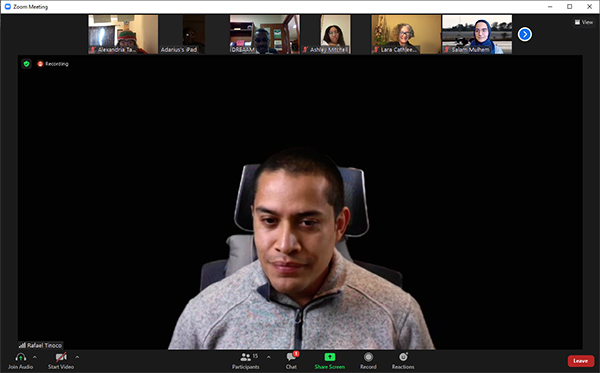
Civil Engineering Assistant Professor Rafael Tinoco Lopez during the Friday, November 20th Zoom Showcase.
“Families will gain a better of understanding of what engineering is and the many different types of engineering that are possible.” explains Lara Hebert, Grainger Engineering’s Outreach & Public Engagement Coordinator. Regarding their goals, Tinoco Lopez adds: "We envision a shift in the understanding of kids and families of the challenges and opportunities in pursuing and being successful in STEM careers. Through their interaction with engineering students, we want to foster a STEM identity and self-efficacy of the kids and family members."
IMAGINE was funded by a grant from the GIANT (Grassroots Initiatives to Address Needs Together) program from Grainger’s IDEA (Inclusion, Diversity, Equity and Access) Institute. "Our goal is to help them visualize themselves in their dream careers and be able to imagine a future in STEM without self-imposed limits," shares Tinoco Lopez. "Since we were applying for the GIANT program in the IDEA institute, we thought we should have an acronym that would do them justice—IMAGINE was just a perfect fit."
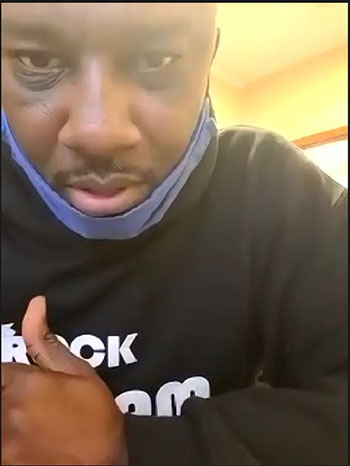 DREAAM's Tracy Dace shares during December's Friday night Showcase.
DREAAM's Tracy Dace shares during December's Friday night Showcase.When describing the University-community partnership responsible for IMAGINE, nothing could be more apropos than the famous African proverb, “It takes a village.” The outreach is a collaboration between Grainger College of Engineering, Urbana’s DREAAM (Driven to Reach Excellence and Academic Achievement for Males) program, and students in several engineering RSOs (Registered Student Organizations), including National Society for Black Engineers (NSBE) and Engineering Ambassadors.
IMAGINE’s leadership team, besides Tinoco Lopez and Hebert, includes Tracy Dace, Founder and Executive Director of DREAAM, and its Youth & Family Service Director, Stephanie Cockrell. And lest the reader think the IMAGINE is only reaching out to DREAAM boys, the not-for-profit also has a Teen REACH (Responsibility, Education, Achievement, Caring, and Hope) Program funded by the Illinois Department of Human Services. The after-school, state-funded middle school program is led by Cockrell, who also runs her own non-profit for underserved girls, called the Well Experience.
Regarding the “village” it takes to run IMAGINE, Hebert adds, “What I love about all of this is how much of a team, how much of a collaborative, community-university partnership we have that's going on. They're great relationships that I look forward to continuing to grow and nurture.”
According to Hebert, IMAGINE was the brainchild of Tinoco Lopez, who's been working with DREAAM outreach activities since 2018, is the father of two DREAAMers, and helped co-write the grant. However, he claims, "It has many parents," and that it originated from a discussion with Dace and Hebert. Acknowledging that the three of them brainstormed this project after seeing the call for the GIANT RFP, he claims Dace has been instrumental in contacting, recruiting, and motivating families to participate, while Hebert (the project PI) has been leading the design of the sessions and coordinating student groups developing the activities.

A young IMAGINE participant shares during the November Friday night Showcase.
“Rafael took the lead on getting this rolling," says Hebert, "We wanted to provide the opportunity for students to have a clear understanding of what engineering really is. One of many reasons why we don't see more students of color, particularly Black and Latino, coming into engineering—they don't have a clear picture of what it actually is. So this is why we're doing this with families.” Hebert claims the shared goal of Grainger, DREAAM, and the numerous volunteers is “To just make it more clear as to what engineering is and how to make it more accessible for students and families, so they can see themselves as future engineers.”
Tinoco Lopez agrees: "We believe that most kids are already interested in some level in science and engineering, but there are a lot of factors, including misconceptions and lack of information, that might make them perceive STEM careers as something not viable or out of reach for them."
One component that sets IMAGINE apart from many outreach efforts is the emphasis on family. "We believe that working with only kids, we can address some of these misconceptions, but their progress can be undone if they hear contradicting views at home," Tinoco Lopez emphasizes.
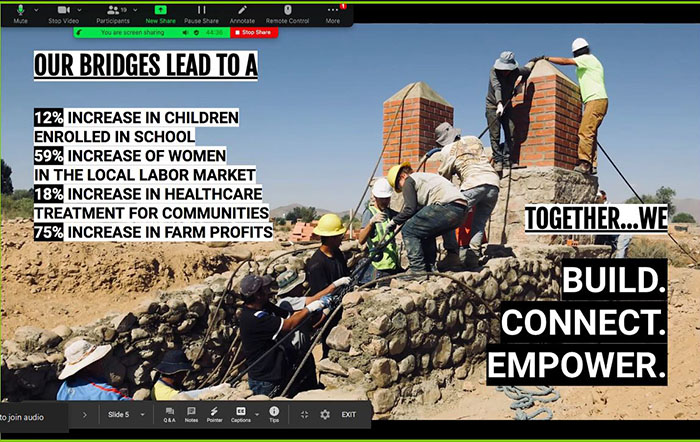 One slide from the Engineers in Action Bridge Program RSO shows the important work the group does building bridges around the world—work the youngsters might be able to get involved in should they seek to study civil engineering.
One slide from the Engineers in Action Bridge Program RSO shows the important work the group does building bridges around the world—work the youngsters might be able to get involved in should they seek to study civil engineering."By including the whole family in an informal setting, not lecturing but working together on Family Nights, the kids will feel more support and encouragement from home while allowing us to showcase and discuss STEM opportunities and challenges through the eyes of both children and their parents."
So what's the program like? It was initially intended to be a couple of hours in the evening, starting with dinner, followed by families doing a STEM activity together, and ending with a discussion around the equity and access topic for that month.
"Looking at the various types of misconceptions and myths about STEM careers, we decided to follow a three-prong approach," shares Tinoco Lopez: "bringing families together, showcasing opportunities in different Engineering fields by leveraging collaborations with student organizations at U of I, and discussing possible misconceptions about challenges and opportunities in careers in STEM."

Engineering’s Outreach & Public Engagement Coordinator, Lara Hebert, chats with participants during a Friday night Showcase Zoom meeting.
The original idea consisted on a hands-on STEM activity for families to play together with basic engineering concepts while interacting with Engineering students, followed by a presentation to an Engineering field related to their activity, and concluding with an "Engineering Myth-Busters" discussion on challenges and opportunities to pursuing such careers. However, due to COVID-19, the partners had to rethink what that would look like in a virtual setting.
“What I really enjoyed is that it's not the university making a decision about what it should look like,” Hebert says. “It's really a shared conversation between the DREAAM leaders and the College about how to make this work for all of us.” She admits it took a while to “hammer down what this would look like online, how to meet the needs for the communal collaboration conversation, network building, and that sense of community while also being separate.”
The final, COVID-friendly, online version of IMAGINE looks like this: Instead of one night, it's a week-long opportunity; families can decide when and how to fit it in. Each month focuses on both a different engineering major and a different equity and access emphasis. IMAGINE also provides at-home STEM kits which participants pick up on Friday the week before the week-long event.
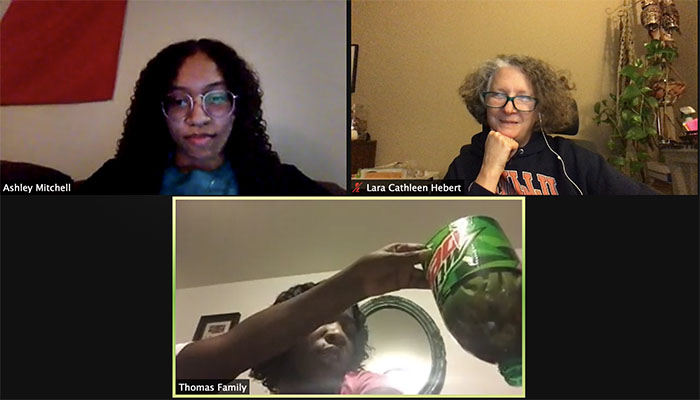
Ashley Mitchell and Lara Hebert attend the December 8th IMAGINE office hours while a member of a local family works on the design challenge.
The STEM Nights week looks something like this. On Monday, the website is available. It contains a design challenge related to the major, a video about science and engineering that families should know in order to make their STEM challenge design, plus videos related to the major being emphasized. The idea is that families are to work through the activities on the website on Monday–Thursday,. IMAGINE Office Hours are Tuesday from 5:30–7:00 pm, during which participants can ask questions about the week’s activities, work on their challenge with others, or visit with Illinois engineering students. Friday from 6:00–7:00 pm is the Showcase, during which participants share their designs, discuss the week’s events, experience guest presentations, and participate in a raffle to celebrate the week of Family STEM time, which Tinoco Lopez says is to "share their outcomes and conduct our myth-busting discussion with the whole family at home."
“The goal is that they have their STEM challenge done by Friday,” Hebert explains, “and then we have a showcase where we come together and share our designs with one another. And then we also engage in that conversation around equity and access.”
 Part of an explanation about the forces that make a rocket fly included in the Aerospace video: The Science of Rocket Design.
Part of an explanation about the forces that make a rocket fly included in the Aerospace video: The Science of Rocket Design. The first week of IMAGINE, from November 16–20th, 2020, emphasized Aerospace Engineering, and the myth-busting discussion was about representation in engineering. For the first activity, the nine families who signed up to participate were asked to work together to draw and color What Comes to Mind When You Picture an Engineer, and then were encouraged to take a picture of it and post it. The November design challenge was to design and build a rocket and rocket launcher. A video called The Science of Rocket Design was made available to help participants. Plus, to learn more about Aerospace Engineering, participants were encouraged to watch the following videos: This is Aerospace Engineering at the University of Illinois, a video from a student about why they chose Aerospace, and Mae Jemison: I Wanted to Go Into Space.
 December's Civil Engineering Design Challenge: The Stinky City Clean Water Challenge (left) and relevant water quality data (right).
December's Civil Engineering Design Challenge: The Stinky City Clean Water Challenge (left) and relevant water quality data (right).Eleven families participated in the December IMAGINE, from December 7–11th, which addressed Civil and Environmental Engineering (CEE); the design challenge was: The Stinky City Clean Water Challenge and the possible misconception addressed was skills. Instructions regarding the design challenge were posted, along with other resources, including a video (Science Behind How Water is Cleaned), and a video about How to Use the Water Quality Testing Kit, which families were to use to test their filtered water to see how well the filter they designed had worked. Participants were also encouraged to record a video of their final test and post it. To help participants discover more about Civil Engineering, several videos were made available: Civil and Environmental Engineering at Illinois; plus, some CEE students, one from the Society of Hispanic Professional Engineers and two from the Society for Women in Engineering shared why they chose to major in Civil and Environmental Engineering.
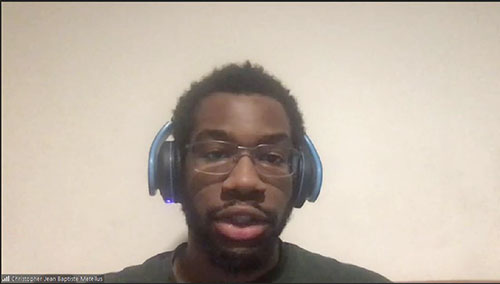
NSBE External Vice-President Christopher Metellus shares during the December Friday night Showcase.
Helping create website content are members of a number of RSOs. For example, taking the lead on generating content are a couple of students from NSBE: Christopher Metellus, a MechSE junior and NSBE External Vice-President, along with Outreach Committee member Ashley Mitchell, who are collaborating with the content-specific RSOs. For November’s content, for example, the ISS (Illinois Space Society) and Formula SAE Illini Motorsports collaborated with NSBE and Engineering Ambassadors to create the November design challenge and content videos and post that info on the website. The December RSOs (in addition to NSBE and EA) included the Engineers in Action Bridge Program and Water Environment Federation. Additionally, Robin De Lara, president of Engineering Ambassadors, has been producing science content videos for each month.
While the program is aimed at local youth and their families, planners envision a broader impact. Thus, Alexandria Cervantes, a College of Education grad student in the MSE (Mathematics, Science, & Engineering Education) program, is helping to conduct an evaluation study of the program’s effectiveness in order to provide relevant information to others who might want to employ this sort of model.
Tinoco Lopez says answers to the following research questions will help the planners upscale efforts, provide similar programs in other communities, and to better understand institution-community-family interactions to achieve greater diversity in STEM.
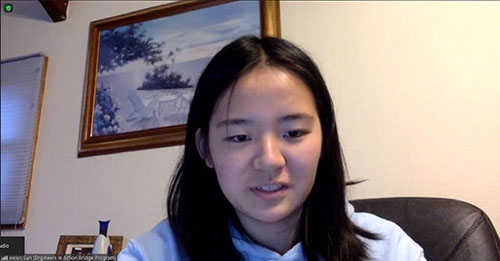
Helen Sun of the Engineers in Action Bridge Program shares about their bridge-building activities.
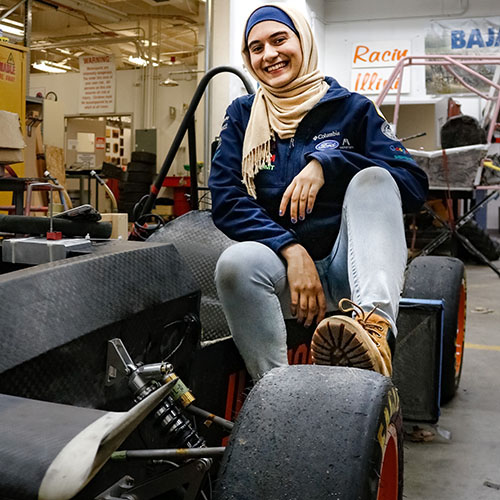
Aerospace Engineering senior Salam Mulhem shows off one of Formula SAE Illini Motorsports vehicles.
- To what extent does explicit instruction into hidden rules, systemic barriers, and untapped resources for minority participation in STEM provide useful tools for families to navigate the education system?
- Does this instruction influence the child’s and family’s beliefs about the child’s future success in STEM?
- Does family engagement in STEM challenges increase interest and positive self-efficacy toward a future in STEM careers?
- In what ways do student volunteers’ perceptions of community and youth STEM identity change through work with DREAAM House youth and families?
What impact have they seen thus far? Tinoco Lopez appreciates the kids' enthusiasm and the involvement of the families (including parents, grandparents, and siblings). He reports that they've shown interest and gotten involved in the activities showcased by student organizations, and they anticipate increased participation and interaction as everyone becomes more familiar with the format.
In fact, at the end of the November Aerospace session, one mom was particularly appreciative that her kids were seeing African Americans in leadership roles in IMAGINE:“This has really inspired…Our boys can actually see that there are Black people doing this, where it isn’t saying that only one race can be an engineer, but there’s Black organizations and Black people running things…I really like the diversity that was set upon our boys, for them to have an eye opener to this.”
Numerous engineering students volunteered their time and skills to IMAGINE, often hoping to provide youngsters something they hadn't had access to as kids. For instance, helping with the November 20th Showcase was Salam Mulhem, a senior in Aerospace Engineering and Team President of Formula SAE Illini Motorsports. Mulhem, who grew up in Oak Lawn, Illinois, a south suburb of Chicago, says she chose Aerospace because, “Science has always been really cool to me, and engineering gave me a way to marry it with an interest in space!”
She shares why she got involved with IMAGINE. “I am passionate about teaching others about STEM and empowering them to pursue it, especially younger minority students. I know what it is like to be in their shoes.” Re additional motivation behind her participation in the program, she adds, “I hoped to show them the engineers and scientists come in all shapes and forms, and that their differences are their ultimate strength.”
Her advice for youngsters—all of us, really: “Go after the things that scare you! They teach you the most about something new, and more importantly, about yourself. These experiences are the ones that will shape you the most.”
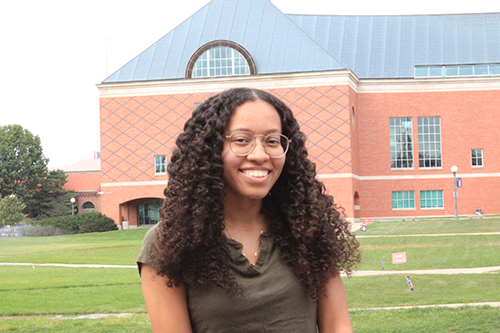
Fifth year Bioengineering senior Ashley Mitchell.
A volunteer who has made significant contributions to IMAGINE is Ashley Mitchell, a fifth year Bioengineering senior from a small town called Broadview in the west suburbs of Chicago, who shares why she got involved. “I love doing STEM outreach, and recently that's been hard to do,” she explains. “But I love that WYSE was able to adapt and put together a virtual outreach opportunity.” Mitchell learned about IMAGINE through NSBE, who mentioned that the new program was looking for volunteers. “I've worked with WYSE on their summer camps before, so I was more than happy to help,” she admits. “I also enjoy seeing kids get excited about science, engineering, and UIUC!”
Another reason she felt it was important to be involved in IMAGINE was its goal of increasing representation of underserved students. “Seeing other students that looked like me—of diverse backgrounds, pursuing engineering—was not something I saw often growing up. I hope that by seeing someone like me at a university like UIUC, studying engineering, the kids are inspired to pursue the same.”
She also acknowledges that the program is needed during the pandemic. “I also believe the activities they do in IMAGINE allow them to think critically and creatively and allow them to bond with their family while at home during these times.”
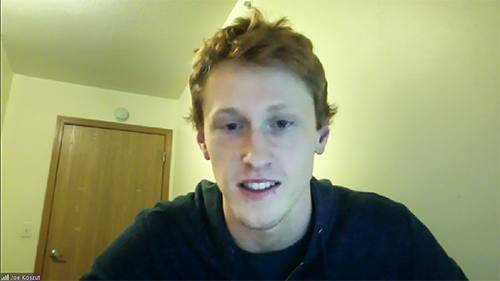
Mechanical Science and Engineering senior Joe Koszut shares with IMAGINE participants during the November 20th Showcase on Zoom.
Also volunteering in IMAGINE was Joe Koszut, a Mechanical Engineering senior who grew up in La Grange, Illinois, in the Chicago suburbs of Chicago. He reports that “Growing up, I enjoyed building and taking things apart, so Mechanical Engineering seemed like a natural path for me to follow.”
Koszut admits that he wasn’t particularly excited about attending college when he was younger. However, he says that since matriculating to Illinois, “I discovered the engaging type of work I initially intended to speed past school to find.” He shares that he got involved in IMAGINE because he “wanted to let younger students know about the plethora of great opportunities which exist in STEM, and that they shouldn’t be discouraged in pursuing them simply due to common misconceptions.”
He adds that his goal in participating in the outreach was to “to give the kids a glimpse of the cool projects engineers work on, such as those on RSOs like Formula SAE, and inspire them to excel in their education and look forward to a future in STEM.”
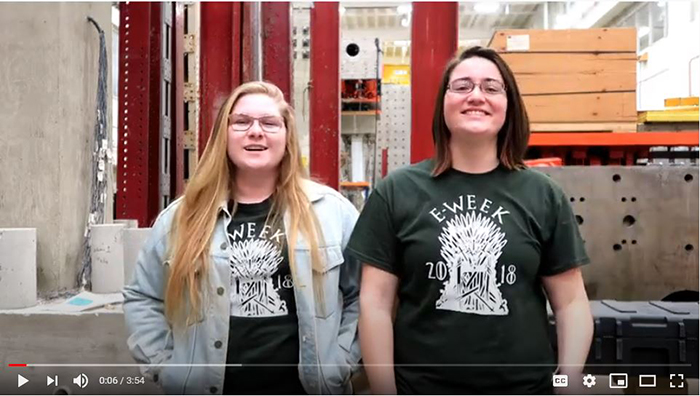 Two Civil and Environmental Engineering students share about what it's like to be a student in their department. (Image taken from video posted on the IMAGINE website.)
Two Civil and Environmental Engineering students share about what it's like to be a student in their department. (Image taken from video posted on the IMAGINE website.)Story and photographs by Elizabeth Innes, Communications Specialist, I-STEM Education Initiative.
More: 6-8 Outreach, DREAAM, WYSE, 2020
For additional I-STEM articles on engineering camps, please see:
- GLEE GAMES Camp Seeks to Spark High School Girls' Interest in Electrical Engineering
- MechSE's WYSE Camp Helps High School Students Explore Mechanical Engineering
- G.A.M.E.S. Campers Learn about Bioengineering While Breaking Down Stereotypes
- High School Girls Discover Chemical & Biomolecular Engineering at GAMES Camp
- Girls Experience Electrical Engineering First-Hand at the 2016 GLEE GAMES Camp
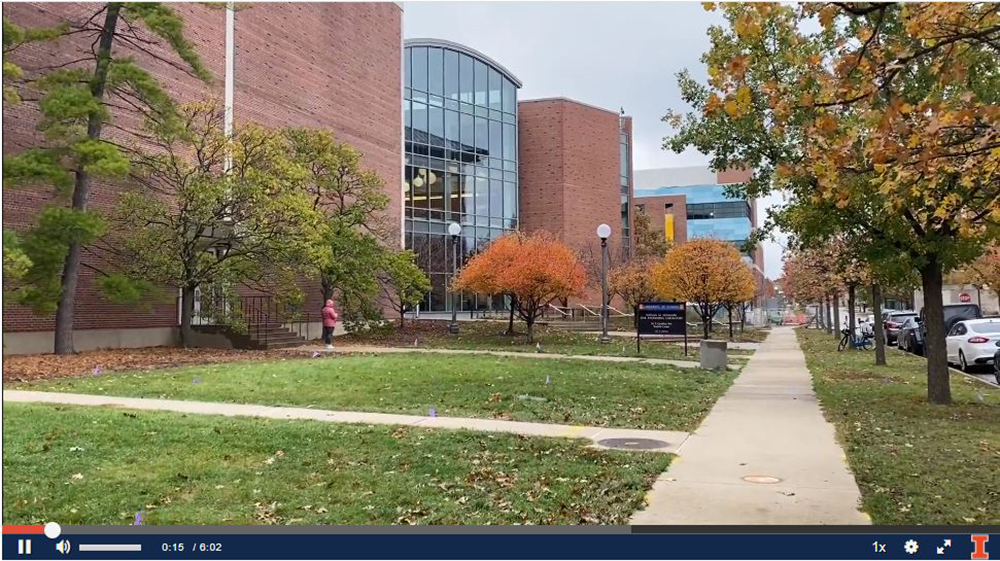
A shot of Newmark Lab, home of CEE, during the Civil and Environmental Engineering video which included a tour of key buildings. (Image taken from video posted on the IMAGINE website.)













.jpg)
















